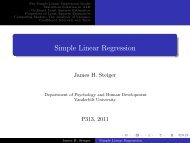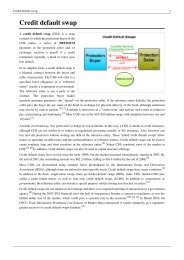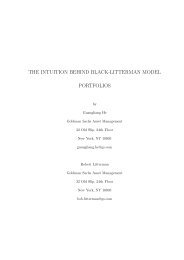The vanna-volga method for implied volatilities
The vanna-volga method for implied volatilities - Risk.net
The vanna-volga method for implied volatilities - Risk.net
Create successful ePaper yourself
Turn your PDF publications into a flip-book with our unique Google optimized e-Paper software.
0 <strong>for</strong> each K > 0. This property, which is not true in general 10 ,<br />
holds however <strong>for</strong> typical market parameters, so that (7) leads to<br />
prices that are arbitrage-free in practice.<br />
<strong>The</strong> VV <strong>implied</strong>-volatility curve K → ς(K) can be obtained by<br />
inverting (7), <strong>for</strong> each considered K, through the BS <strong>for</strong>mula. An<br />
example of such a curve is shown in figure 1. Since, by construction,<br />
ς(K i<br />
) = σ i<br />
, the function ς(K) yields an interpolation-extrapolation<br />
tool <strong>for</strong> the market <strong>implied</strong> <strong>volatilities</strong>.<br />
Comparison with other interpolation rules<br />
Contrary to other interpolation schemes proposed in the financial<br />
literature, the VV pricing <strong>for</strong>mula (7) has several advantages: it<br />
has a clear financial rationale supporting it, based on the hedging<br />
argument leading to its definition; it allows <strong>for</strong> an automatic calibration<br />
to the main volatility data, being an explicit function of<br />
σ 1<br />
, σ 2<br />
, σ 3<br />
; and it can be extended to any European-style derivative<br />
(see our second consistency result below). To our knowledge, no<br />
other functional <strong>for</strong>m enjoys the same features.<br />
Compared, <strong>for</strong> example, with the second-order polynomial<br />
function (in Δ) proposed by Malz (1997), the interpolation (7)<br />
equally perfectly fits the three points provided, but, in accordance<br />
with typical market quotes, boosts the volatility value both <strong>for</strong><br />
low- and high-put deltas. A graphical comparison, based on market<br />
data, between the two functional <strong>for</strong>ms is shown in figure 1,<br />
where their difference at extreme strikes is clearly highlighted.<br />
<strong>The</strong> interpolation (7) also yields a very good approximation of<br />
the smile induced, after calibration to strikes K i<br />
, by the most<br />
renowned stochastic-volatility models in the financial literature,<br />
especially within the range [K 1<br />
, K 3<br />
]. This is not surprising, since<br />
the three strikes provide in<strong>for</strong>mation on the second, third and<br />
fourth moments of the marginal distribution of the underlying<br />
asset, so that models agreeing on these three points are likely to<br />
produce very similar smiles. As a confirmation of this statement,<br />
in figure 1, we also consider the example of the SABR functional<br />
<strong>for</strong>m of Hagan et al (2002), which has become a standard in the<br />
market as far as the modelling of <strong>implied</strong> <strong>volatilities</strong> is concerned.<br />
<strong>The</strong> SABR and VV curves tend to agree quite well in the range set<br />
A. Discount factors: July 1, 2005<br />
Expiry Dollar Euro<br />
3M: October 3, 2005 0.9902752 0.9945049<br />
B. Strikes and <strong>volatilities</strong> corresponding to the three<br />
main deltas: July 1, 2005<br />
Delta Strike Volatility<br />
25D put 1.1720 9.79%<br />
At-the-money 1.2115 9.375%<br />
25D call 1.2504 9.29%<br />
by the two 10Δ options (in the given example they almost overlap),<br />
typically departing from each other only <strong>for</strong> illiquid strikes.<br />
<strong>The</strong> advantage of using the VV interpolation is that no calibration<br />
procedure is involved, since σ 1<br />
, σ 2<br />
, σ 3<br />
are direct inputs of<br />
<strong>for</strong>mula (7).<br />
In figure 1, we compare the volatility smiles yielded by the VV<br />
price (7), the Malz (1997) quadratic interpolation and the SABR<br />
functional <strong>for</strong>m 11 , plotting the respective <strong>implied</strong> <strong>volatilities</strong> both<br />
against strikes and put deltas. <strong>The</strong> three plots are obtained after<br />
calibration to the three basic quotes σ 1<br />
, σ 2<br />
, σ 3<br />
, using the following<br />
euro/dollar data as of July 1, 2005 (provided by Bloomberg):<br />
T = 3M, 12 S 0<br />
= 1.205, σ 1<br />
= 9.79%, σ 2<br />
= 9.375%, σ 3<br />
= 9.29%, K 1<br />
=<br />
1.1720, K 2<br />
= 1.2115 and K 3<br />
= 1.2504 (see also tables A and B).<br />
Once the three functional <strong>for</strong>ms are calibrated to the liquid<br />
quotes σ 1<br />
, σ 2<br />
, σ 3<br />
, one may then compare their values at extreme<br />
strikes with the corresponding quotes that may be provided by brokers<br />
or market-makers. To this end, in figure 1, we also report the<br />
<strong>implied</strong> <strong>volatilities</strong> of the 10Δ put and call options (respectively<br />
equal to 10.46% and 9.49%, again provided by Bloomberg) to show<br />
that the Malz (1997) quadratic function is typically not consistent<br />
with the quotes <strong>for</strong> strikes outside the basic interval [K 1<br />
, K 3<br />
].<br />
10<br />
One can actually find cases where the inequality is violated <strong>for</strong> some strike K<br />
11<br />
We fix the SABR β parameter to 0.6. Other values of β produce, anyway, quite similar calibrated<br />
<strong>volatilities</strong><br />
12<br />
To be precise, on that date the three-month expiry counted 94 days<br />
<br />
<br />
<br />
<br />
<br />
<br />
<br />
Untitled-1 1 5/1/07 12:42:24<br />
risk.net 109








